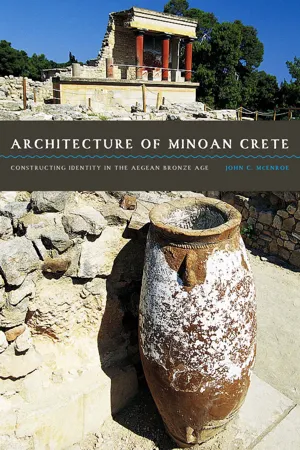
Architecture of Minoan Crete
Constructing Identity in the Aegean Bronze Age
- 220 pages
- English
- ePUB (mobile friendly)
- Available on iOS & Android
About This Book
A comprehensive, scholarly, engaging look at the meanings behind key architectural designs of ancient Minoan culture. Ever since Sir Arthur Evans first excavated at the site of the Palace at Knossos in the early twentieth century, scholars and visitors have been drawn to the architecture of Bronze Age Crete. Much of the attraction comes from the geographical and historical uniqueness of the island. Equidistant from Europe, the Middle East, and Africa, Minoan Crete is on the shifting conceptual border between East and West, and chronologically suspended between history and prehistory. In this culturally dynamic context, architecture provided more than physical shelter; it embodied meaning. Architecture was a medium through which Minoans constructed their notions of social, ethnic, and historical identity: the buildings tell us about how the Minoans saw themselves, and how they wanted to be seen by others. Architecture of Minoan Crete is the first comprehensive study of the entire range of Minoan architecture—including houses, palaces, tombs, and cities—from 7000 BC to 1100 BC. John C. McEnroe synthesizes the vast literature on Minoan Crete, with particular emphasis on the important discoveries of the past twenty years, to provide an up-to-date account of Minoan architecture. His accessible writing style, skillful architectural drawings of houses and palaces, site maps, and color photographs make this book inviting for general readers and visitors to Crete, as well as scholars.
Frequently asked questions
Information
Table of contents
- Cover Page
- Title Page
- Copyright Page
- Dedication
- Contents
- Preface
- Acknowledgments
- The Land, the People, Identity
- Architecture and Social Identity in Neolithic Crete (CA. 7000–3000 BC)
- Local, Regional, and Ethnic Identities in Early Prepalatial Architecture (CA. 3000–2200 BC)
- Architectural Experiments and Hierarchical Identity in Late Prepalatial Architecture (CA. 2200–1900 BC)
- The First Palaces and the Construction of Power (CA. 1900–1750 BC)
- The Protopalatial City and Urban Identity (CA. 1900–1750 BC)
- The Second Palace at Knossos and the Reconstruction of Minoan Identity (CA. 1750–1490 BC)
- Comparing the Neopalatial Palaces (CA. 1750–1490 BC)
- Houses and Towns in the Neopalatial Period (CA. 1750–1490 BC)
- Buildings, Frescoes, and the Language of Power in the Final Palatial Period (CA. 1490–1360 BC)
- After the Palaces (CA. 1360–1200 BC)
- Survival and Memory in LM IIIC (CA. 1200–1100 BC)
- Conclusion
- Appendix
- Notes
- Glossary
- Works Cited
- Index
- Photos